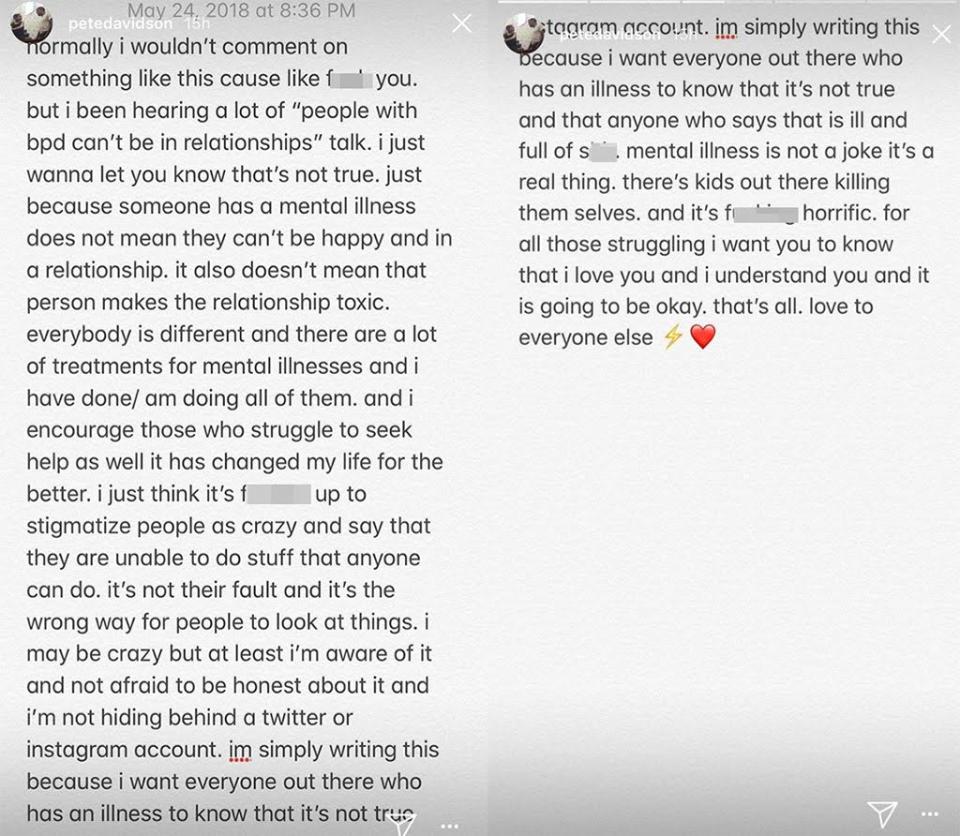Ariana Grande's boyfriend opens up about his borderline personality disorder — here's what that is

In the wake of critics calling Ariana Grande’s decision to date Pete Davidson “trash,” the Saturday Night Live star took to Instagram to defend himself, bringing up his borderline personality disorder (BPD), which he first discussed publicly last year.
“Normally I wouldn’t comment on something like this cause like f*** you,” he shared on his Instagram story Thursday. “But [I’ve] been hearing a lot of ‘people with BPD can’t be in relationships’ talk. I just wanna let you know that’s not true. Just because someone has a mental illness does not mean they can’t be happy and in a relationship. It also doesn’t mean that person makes a relationship toxic.”

Davidson first went public with his diagnosis in a September podcast episode of WTF With Marc Maron, where he discussed checking himself into rehab for what he thought were marijuana-induced mental breakdowns. “I started having mental breakdowns where I would, like, freak out and then not remember what happened after. Blind rage,” he told Maron, according to Rolling Stone. “I never really did any other drugs, so I was like, ‘I’m gonna try to go to rehab. Maybe that’ll be helpful.’”
Once Davidson was in rehab, doctors told him that he might be suffering from bipolar disorder and recommended that he start treatment with a therapist. Soon after, a psychiatrist diagnosed him with borderline personality disorder. Davidson, who is currently undergoing dialectical behavior therapy (DBT) to treat it, shed light on what it’s like with Maron. “You have this thought … these feelings and urges to freak out,” he said. “[So you] try waiting it out 10 minutes, try going for a walk.”
As the 24-year-old continues to navigate his mental illness and explore a relationship with the queen of ponytails, here’s a breakdown of everything you need to know about the disorder.
It’s not uncommon.
Although it’s rarely discussed in the mainstream media, BPD is not uncommon. According to the National Alliance on Mental Illness, the condition affects anywhere from 1.6 to 5.9 percent of adults in the U.S., or 3 million people overall. Allison Abrams, a psychotherapist in New York City, treats many patients with the condition and says that myths about it abound. “It’s much more common than people realize,” she tells Yahoo Lifestyle. “A lot of people think that only women have borderline but that’s not true. The majority are women, but men have it too.”
A major symptom is difficulty maintaining stability — in both relationships and moods.
One of the major distinguishing factors about BPD is that those who have it struggle with severe mood swings — some of them just hours long — that make it difficult to have healthy relationships. “[BPD] is marked by a pattern of unstable interpersonal relationships. That’s really the core of it,” says Abrams. “It’s difficult to maintain stability in their relationships and moods. They’re very sensitive to any interpersonal slight they may see, and they’re triggered by these conflicts.”
A post shared by Pete Davidson (@petedavidson) on May 17, 2018 at 11:18am PDT
It often strikes people with major childhood trauma — such as the loss of parent.
In his interview with Maron, Davidson cited the death of his father (a firefighter) during 9/11 as one of the things that fuel his BPD. “My big thing is trust. You know, one day [my dad] was here and the next day he was gone,” Davidson, who was 7 when his dad died, told Maron. “When people say they’re leaving and coming back, I get a really big fear that they’re not gonna come back.”
His experience of losing someone, and the subsequent fear of abandonment, are common in people with BPD. “Most people who develop it have a history of abuse, neglect, and abandonment — some type of trauma in their childhood,” says Abrams. “They didn’t have their needs met by their caregiver, so they become hypersensitive to anything that may look like criticism or rejection.”
Those who have it tend to see relationships with others in black and white.
A major issue for those with BPD is the inability to see the whole picture. “They develop this dichotomous thinking where everything is black and white. It’s hard for them to integrate, so they idealize people first — to an extreme — but once they see negative feedback, they go the other extreme and demonize them,” says Abrams. “There’s not much in-between. Many times they will cut people out of their lives entirely as soon as there is any sign of rejection.”
This conflict can lead to self-destructive behaviors.
While not everyone with BPD will show self-destructive behaviors, Abrams says, it’s a distinguishing factor of the mental illness. “There is a chronic sense of emptiness or boredom, so sometimes you may see instability in career goals or other goals, a general feeling of not knowing who you are,” she says. “And often there is some self-destructive behavior, such as drug or alcohol abuse, self-harm, binge eating, overspending, things like that.”
It doesn’t mean that those with BPD don’t have empathy.
While the mood swings can sometimes cast people with BPD in a negative light, Abrams says, those with BPD feel things, including other people’s pain, deeply. “One of the major myths is that they’re not empathetic, but it’s quite the contrary. For many, because they are so hypersensitive, they’re very in tune with what people are thinking; they can read people and understand what they’re thinking,” Abrams says. “They’re very intuitive.”
Like other mental health conditions, it’s treatable — and has a great prognosis.
The main treatment for BPD — which Davidson himself has discussed — is dialectical behavior therapy, a method that provides practical tools to help patients navigate difficult emotions and conflict. With this treatment or others, Abrams says, individuals with BPD can thrive. “They can certainly be in a healthy relationship. These aren’t flaws; they’re difficulties people have because they didn’t develop the skills to cope or to self-soothe,” she says. “These are not things that were in their control, and so they want — just like all of us — to be loved. It’s absolutely not true that they can’t be in relationships, and I’m glad that people are starting to come out and say that. This is how we break the stigma.”
Read more from Yahoo Lifestyle:
Despite anxiety issues, Lisa Rinna’s daughter slayed Australia Fashion Week
Ryan Reynolds opening up about his anxiety has the power to help millions
Follow us on Instagram, Facebook, and Twitter for nonstop inspiration delivered fresh to your feed, every day.
